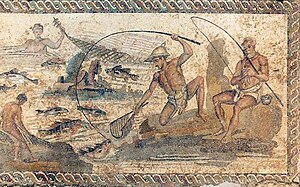
Back Hengel Afrikaans Pesca con lata de pescar AN صيد بالصنارة Arabic Pagbanwit BCL ছিপ Bengali/Bangla Pesca de fons Catalan Angeln German Fiŝhokado Esperanto Pesca con caña Spanish Õngitsemine Estonian



Angling (from Old English angol, meaning "hook") is a fishing technique that uses a fish hook attached to a fishing line to tether individual fish in the mouth. The fishing line is usually manipulated via a fishing rod, although rodless techniques such as handlining also exist. Modern angling rods are usually fitted with a fishing reel that functions as a cranking device for storing, retrieving and releasing out the line, although Tenkara fishing and traditional cane pole fishing are two rod-angling methods that do not use any reel. The fish hook itself can be additionally weighted with a denser tackle called a sinker, and is typically dressed with an appetizing bait (i.e. hookbait) to attract and entice the fish into swallowing the hook, but sometimes an inedible fake/imitation bait with multiple attached hooks (known as a lure) is used instead of a single hook with edible bait. Some type of bite indicator, such as a float, a bell or a quiver tip, is often used to relay underwater status of the hook to the surface and alert the angler of a fish's presence.
When angling, the fisherman (known as the angler) will first throw the hook (i.e. "cast") to a chosen area of water (i.e. fishing ground), and then patiently wait for fish to approach and devour the hookbait. It is also not uncommon for the angler to scatter some loose bait (groundbait) around the target area before even casting the hook, to better attract distant fish with scents. If a fish has succumbed to its own feeding instinct and swallowed the baited hook (i.e. "bite" or "strike"), the hook point will likely pierce into and anchor itself inside the fish jaw, gullet or gill, and the fish in turn becomes firmly tethered by the fishing line. Once the fish is hooked (often colloquially called "fish-on"), any struggles and attempts to escape will pull along the line, causing the bite indicator to signal the angler, who jerks the fishing rod back to further deepen the hook anchorage (i.e. "setting the hook") and then tries to retrieve the line back, pulling the fish closer in the process. During the line retrieval, the angler will carefully monitor the line and rod tension to avoid equipment breaking. With stronger and feistier fish, the angler might need to temporarily halt or even reverse the line retrieval to prolong the struggle time and tire out the fish (i.e. "walking" the fish), before dragging it near enough to eventually lift it out of the water (known as "landing") for a successful catch. Sometimes a hand net (or "landing net") or a long-handled hook is used to make fetching the fish easier.
Angling is the principal method of recreational fishing, but commercial fisheries also use angling methods such as longlining, trotlining or trolling. In many parts of the world, a fishing licence is mandated for angling and size limits apply to certain species, meaning by law, fish below and/or above a certain size range must be released alive after capture. The popular fish species pursued by anglers, collectively known as game fish, vary with geography. Among the many species of saltwater fish that are angled for sport globally are billfish (swordfish, sailfish and marlin), tuna, trevally and grouper, while cod and sea bass are popular targets in Europe. In North America, the popular freshwater fish species include bass, northern pike/muskellunge, walleye, trout and anadromous salmon, tilapia, channel catfish and panfishes such as crappie, sunfish (e.g. bluegill) and yellow perch. In Europe, Asia and Australasia, freshwater anglers often pursue species such as carp, pike, bream, tench, rudd, roach, European perch, catfish and barbel, many of which are regarded as undesirable "rough fish" in North America. In developed countries, catch and release angling is increasingly practiced by sport fishermen in recent years to conserve the fish stocks and help maintain sustainability of the local fisheries.
Angling is not to be confused with snagging, another fishing technique that also uses line and hook to catch fish. The principal differences between the two techniques are that angling often uses very small hooks and relies on the target fish itself to voluntarily swallow the hook to pierce internally into the fish's mouth; while snagging uses very large, sharp, multi-pointed grappling hooks that actively "claw" and pierce externally into the body/gill of the fish, and hardly ever involves any hookbait. Snagging also inflicts far more mutilating injuries to the fish and makes it very difficult to heal and survive even if the fish is released alive or manages to escape the snag.